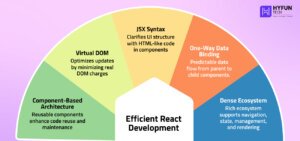The appropriate front-end technology may make or kill a modern web project. Angular and React are popular for building rich single-page apps. At Hyfuntech, being a prominent web development firm, we have dealt with both frameworks and know how different they are. This extensive guide compares React with Angular’s architecture, data binding, performance, learning curve, and optimum use cases (previously known as AngularJS and ReactJS).
We know that Google’s Angular web framework and Facebook’s React JavaScript library are open-source. Many web developers utilize both technologies, although they take distinct methods. This article will help you choose React or Angular for your next project. This industry dispute is widespread, so we prepared this guide to assist you in making an informed decision now!
Table of Contents
What is Angular or AngularJS?
Google maintains the open-source web application framework Angular (also termed Angular 2+ to distinguish it from AngularJS). The 2016 successor to AngularJS (2010), modern Angular uses TypeScript and a component-based architecture. Angular is opinionated and comprehensive, supporting routeing, forms, HTTP requests, and more. A superset of JavaScript, TypeScript adds static typing and sophisticated tooling to Angular apps. Large, enterprise-grade single-page applications (SPAs) benefit from Angular’s organized framework and robust typing for maintainability.
Features of Angular
Developers adore Angular’s built-in features:

Two-Way Data Binding: Angular automatically synchronizes model and UI data. This implies the UI updates when the data model does and vice versa.
TypeScript-Based: Angular encourages its use. TypeScript’s static type checking and contemporary JavaScript capabilities catch compile-time mistakes and increase code quality.
Dependency Injection: Angular ships with dependency injection. This style automatically provides dependencies for components and services, making code more modular and testable.
Angular CLI: The powerful Angular Command Line Interface (CLI) streamlines project setup, code generation, testing, and deployment. It accelerates development and enforces best practices. React apps use Jest or other testing tools, whereas Angular’s CLI configures a Jasmine/Karma testing environment by default.
Advanced Architecture: Module, component, and service architecture gives massive codebases organization in Angular programs.
Rich Ecosystem: Angular has built-in HTTP, animations, forms, and internationalization libraries, decreasing the requirement for external solutions.
Use Cases for Angular
Its structured approach makes Angular ideal for large, complicated projects, especially in enterprise contexts. Applications that require long-term maintainability and uniformity across a large workforce benefit from it. Google, PayPal, Upwork, Forbes, and Samsung use Angular. We use Angular to construct huge dashboards, administration panels, and ecommerce sites at Hyfuntech because its opinionated architecture provides uniformity and scalability.
What is React JS or React?
Facebook (now Meta) developed and maintains React, an open-source JavaScript package. React ignores routeing and data fetching and simply builds UI components, unlike Angular. In declarative React, developers build simple, reusable components in JSX syntax (JavaScript with HTML-like elements) and then compose them into entire user interfaces. React is known for its simplicity and efficiency. A virtual DOM lets React update only the sections of a page that need to change, making it quick for dynamic content. Facebook, Instagram, Netflix, and Airbnb use React frontends.
Features of React
React has various unique features:

Component-Based Architecture: React UIs use reusable components that encapsulate HTML, CSS, and JavaScript. Modularity simplifies code reuse and maintenance.
Virtual DOM: To optimize updates, React employs a virtual (in-memory) DOM. React diffs the virtual DOM and makes minimal changes to the real DOM when state changes, boosting performance.
JSX Syntax: JavaScript’s JSX syntax lets you express HTML-like code directly in React components. JSX clarifies and expresses UI component structure.
One-Way Data Binding (Unidirectional Flow): Data flows from parent to child components in React, making data flow more predictable. Top-level component state updates cascade down the component tree.
Dense Ecosystem: React’s rich ecosystem includes React Router (for navigation), Redux or MobX (for state management), and Next.js (for server-side rendering). Performance-focused frameworks like Next.js and Gatsby leverage React to provide server-side rendering and static generation. Its ecosystem also relies on React Native for mobile.
Use Cases for React
React’s versatility makes it ideal for many web and mobile projects. Applications that need a dynamic interface or integration with various tools use it. Popular examples include Facebook, Instagram (developed by React founders), Netflix, Yahoo, and The New York Times. The Hyfuntech React web development team uses React to construct interactive dashboards, dynamic content sites, and cross-platform mobile apps (via React Native).
Difference Between Angular and React
Both Angular and React can develop modern web apps, but they approach it differently. Some of their significant differences are…
Architecture
Angular is an MVC framework, while React is a lightweight UI library. Angular requires a project structure and has built-in solutions, while React lets developers choose their architecture. Hygraph explains that Angular uses a structured MVC approach, while React uses a flexible component-based architecture for reusable UI components. Since it prioritizes convention over configuration, Angular enforces numerous best practices by default. React is more open-ended, letting developers choose state management, routing, and app design styles.
Language
Angular code uses TypeScript for static typing. React leverages TypeScript and JavaScript (ES6+) for components. TypeScript (like Angular) can catch problems early and improve IDE support, but it adds a layer to understand. Some teams find JavaScript easier to learn, although many large React codebases utilize TypeScript.
Data Binding
How data binding works is a major distinction. By default, Angular employs two-way data binding to sync the view (UI) and model (data). In contrast, React uses unidirectional data binding, where data travels from parent to child. React’s data flow is more predictable and debuggable. The UI in React follows state changes in a controlled one-way flow, but with Angular you can update data or UI immediately. Summary: Angular is two-way binding, React is one-way.

Performance
Each UI update may involve scanning and updating the browser’s document structure because Angular uses the real DOM. React batches and optimizes changes via a virtual DOM. For dynamic interfaces, React generally renders faster. React’s virtual DOM only re-renders modified elements, speeding up updates. Both frameworks continue to optimize: Angular’s new rendering engine (Ivy) and lazy loading minimize bundle size and load times. React 18 and 19 included parallel rendering and Suspense to improve UI responsiveness. React’s technique speeds up UI updates when content changes often.

Learning Curve
Overall, React offers a flatter learning curve. React is mostly about JSX, components, and optional libraries like React Router or Redux. As a comprehensive framework, Angular needs knowing TypeScript, decorators, dependency injection, modules, etc. Angular’s many features make it harder for newcomers, whereas React’s basic core makes it easier for JavaScript developers. Once learned, Angular’s built-in solutions can speed up massive app development.
Tooling and Ecosystem
Large ecosystems, different philosophies. Angular comes with most functionalities; therefore, you may not require many third-party libraries. Due to its tiny core, React uses other packages for routing, state management, and more. React employs Redux, MobX, or the Context API for state management, while Angular’s CLI may scaffold a full application with best practices for easy project creation. Create React App or Vite helps React developers set up. Angular CLI’s default unit testing framework is Jasmine/Karma, while React projects use Jest or equivalent frameworks. Angular provides a complete framework; React lets you choose tools (and take responsibility).
Community & Adoption
React has grown rapidly. According to StackOverflow, 39.5% of developers utilize React and 17.1% Angular. React has more talent and GitHub stars. This makes React developers and community solutions easier to find. Google-backed Angular is popular for corporate stability and has a robust community. Large firms like Google, Microsoft, PayPal, and Samsung employ Angular, which is still popular in banking and healthcare. Both Angular and React are mature and battle-tested, so project fit and team knowledge are more important than capacity.
(Note: some readers search for “React JS vs. Angular JS” because AngularJS (1.x) is obsolete and Angular (2+) is different. ReactJS (released in 2013) had one-way binding and a virtual DOM, while the previous AngularJS had two-way binding and a heavier framework structure.)
4. Pros & Cons
Each has several high-level pros and cons:
The Benefits of Angular
- Inbuilt routing, forms, HTTP, etc. give an all-in-one framework.
- TypeScript and two-way binding boost developer productivity and mistake detection.
- Teams working on big codebases benefit from module and component organization.
- A robust CLI and long-term Google support.
- Enterprise apps with stable needs benefit.
Disadvantages of Angular
- Many topics and complicated terminology make learning difficult.
- Less app structure freedom; more opinionated.
- The framework may be larger and slower to load (lazy loading can assist).
- Smaller projects or TypeScript beginners may struggle.
Advantages of React
- JavaScript-savvy simplicity and learning.
- Select libraries (React Router, Redux, etc.) as needed.
- Virtual DOM improves dynamic interface speed.
- Large community, many third-party libraries, and Meta corporate support.
- Great for bespoke UI and reusable components (React Native extends this to mobile).
React Disadvantages
- No built-in routing or complicated state support; requires libraries.
- Client-side rendering by default can hurt SEO (Next.js helps).
- Updating and breaking changes (library updates) require maintenance.
- If unstructured, huge React apps can become unreliable.
5. When to Use Angular or React?
The choice between Angular and React depends on project needs and team competence. These criteria are from my Hyfuntech experience:
Enterprise web apps (big teams, rigorous architecture): Angular complements complex applications that demand a robust framework. It is stable and well-structured.
Highly dynamic interfaces: Due to its quick rendering, React is ideal for dashboards and interactive data visualizations.
Team expertise: TypeScript-savvy developers from MVC backgrounds will find Angular easier. If your team favors JavaScript/JSX and flexibility, React may be faster.
Project type: React is popular for huge dynamic sites and cross-platform apps, whereas Angular is typical for interactive enterprise apps and PWAs.
SEO requirements: Both frameworks need SEO considerations. Angular apps use Angular Universal for server-side rendering, while React apps use Next.js or Gatsby for pre-rendering. It’s official: the React team endorses Next.js and Gatsby for building apps.
Mobile and cross-platform: Angular (with Ionic) and React (with React Native) offer cross-platform mobile app development. React Native generates native apps, whereas Angular leverages Ionic for hybrid apps. If your team likes Angular’s TypeScript or React’s JavaScript, this decision may vary.
Developer productivity: Angular’s CLI can scaffold a full project with commands and set up testing via Jasmine/Karma, while React developers utilize Create React App or Vite and integrate testing (like Jest).
In conclusion, React and Angular differ in trade-offs. Though Angular is more opinionated and all-in-one, React is flexible and may update faster. Professional web development business Hyfuntech has used both successfully. We might choose Angular for a massive internal admin portal and React for a consumer-facing interactive site. We can help you choose between Angular and React web development due to our knowledge. Most importantly, the right framework fits your team and project goals.
6. Final Verdict
Knowing the differences between Angular and React helps you choose. Two-way binding, a sophisticated CLI, and solid conventions make Angular a complete framework. React’s virtual DOM and component paradigm improve dynamic user interface performance and flexibility. Choose the right tool by assessing team skill set, project complexity, and required flexibility.
Hyfuntech monitors both ecosystems and advises clients. We have experience with enterprise-grade Angular and rapid React web development. The choice between React and Angular depends on project environment and preferences. We quickly adopt new Angular and React capabilities to improve customer services. Angular is good for enterprise apps, while React is good for dynamic UIs. To create a reliable, high-performance app, we customize each project.
Most importantly, the right framework fits your team and project goals.



